TELESCOPE HOUSE AUGUST SKY GUIDE PART 2
DEEP SKY DELIGHTS IN THE SUMMER TRIANGLE
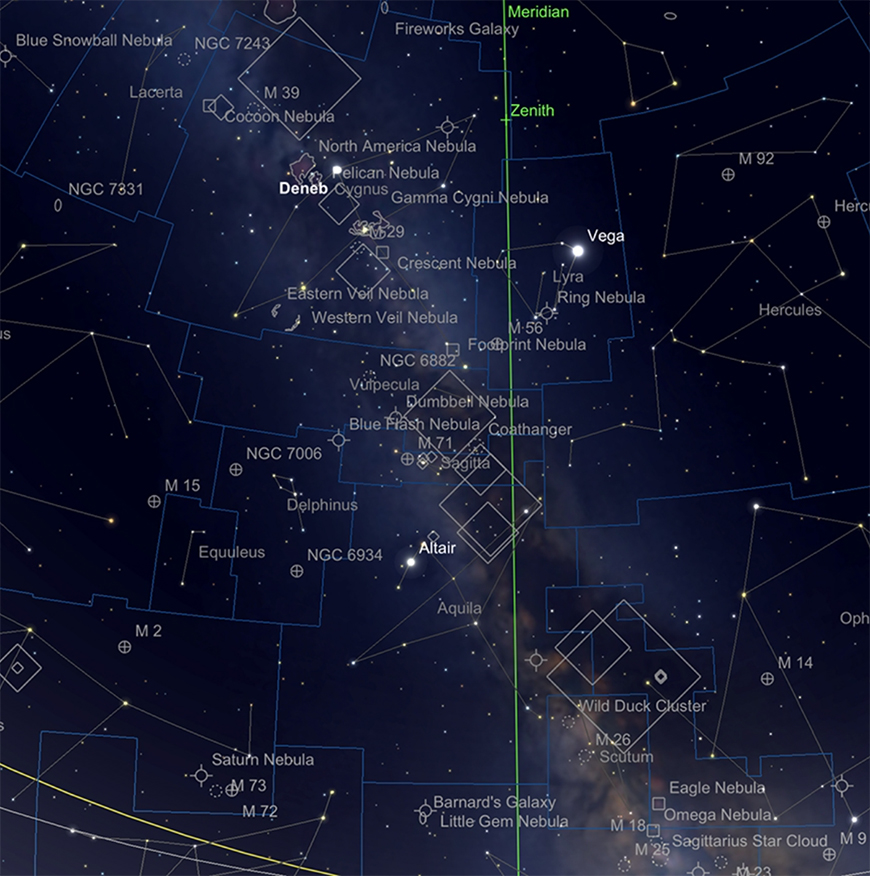
The Summer Triangle. Image created with SkySafari 5 for Mac OS X, ©2010-2016 Simulation Curriculum Corp., skysafariastronomy.com.
The Summer Triangle is an asterism that consists of the stars Vega, Deneb and Altair and was a term first associated with these stars by the Austrian astronomer Oswald Thomas in the early-to-mid 20th century, when he referred to it as Grosses Dreieck (Great Triangle) in the late 1920s and Sommerliches Dreieck (Summerly Triangle) in 1934. This area of sky takes in the constellations of Cygnus, Lyra, Aquila, Vulpecula and Sagitta and contains some of the best deep sky objects in the whole sky.
Starting from the most southerly tip of the Summer Triangle, we come to the major constellation of Aquila, The Eagle. Despite its size and prominent position along the plane of there Milky Way, this constellation is curiously lacking in major Deep Sky objects. The only one of great note is the interesting NGC 6741, otherwise known as The Phantom Streak. This object is a planetary nebula of +11.69 mag and diminutive in size (as many planetaries are), at just 0.1 arc minutes across. Looking like a ghostly parallelogram, the Phantom Streak is not an easy object, but its cocoon-like structure can be discerned by those with access to larger telescopes. It is a rewarding find for those with the ability to find it. The distance of NGC 6741 is not certain. Some sources list it as lying 7000 light years distant, though others think it a closer object at around 5000 light years from us. The Phantom Streak is notable for the possibility that its central star, a white dwarf remnant of a star much like the Sun, may be running out of hydrogen fuel and its dropping in luminosity. This means the Phantom Streak may not be visible in its present form for much longer - a sign we live in a dynamic Universe. Catch it while you can!
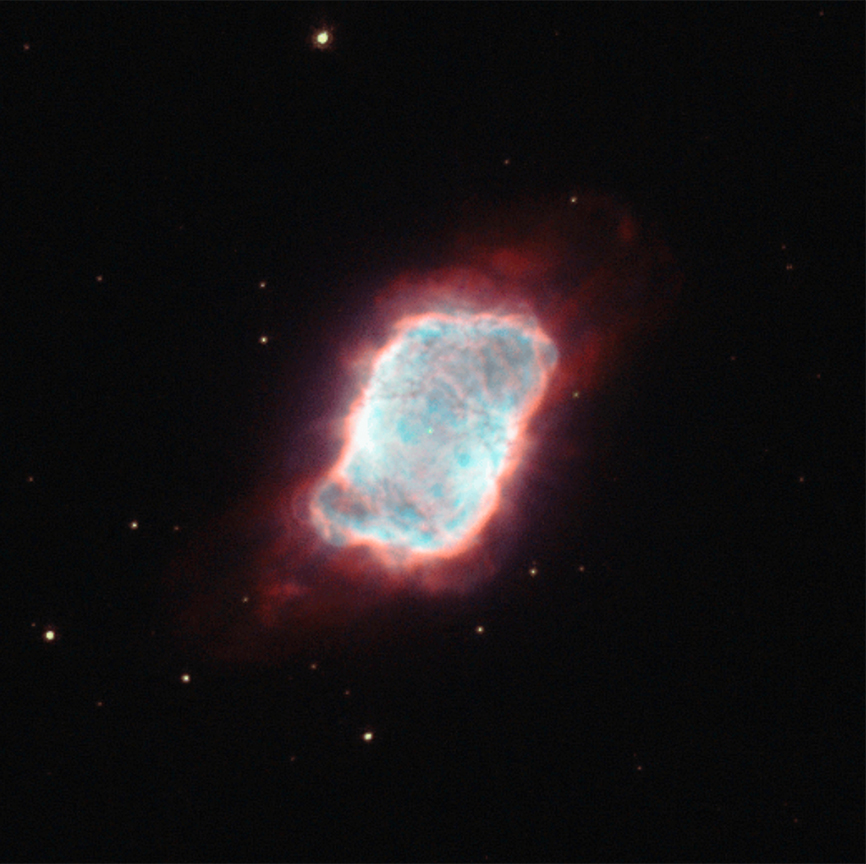
NGC 6741, The Phantom Streak. Image Credit - NASA/ESA Hubble Space Telescope, Creative Commons
Moving up past Altair, we take a brief dog leg East into the tiny constellation of Delphinus, The Dolphin. This lovely little collection of stars, though not especially bright, can easily be made out under dark conditions. Delphinus' kite-shaped arrangement of four stars and the Dolphin's tail marked by the prominently blue Epsilon Delphini is unmistakable.
Delphinus contains two globular clusters - nether particularly bright, but worth seeking out nonetheless. NGC 6934 is the more Southerly and is found just under 11 degrees almost due east of Altair. At +8.8 mag and 1.4 arc minutes in diameter it is hardly prominent, but is location in the rich star fields of the Milky Way go someway to explaining this. Small telescopes show the cluster as a soft, rather indistinct ball of light, but larger instruments will be needed to show the scant detail it offers up to observers. Lying over 50000 light years away, NGC 6934 was one of William Herschel's many discoveries - he first catalogued it in 1785.
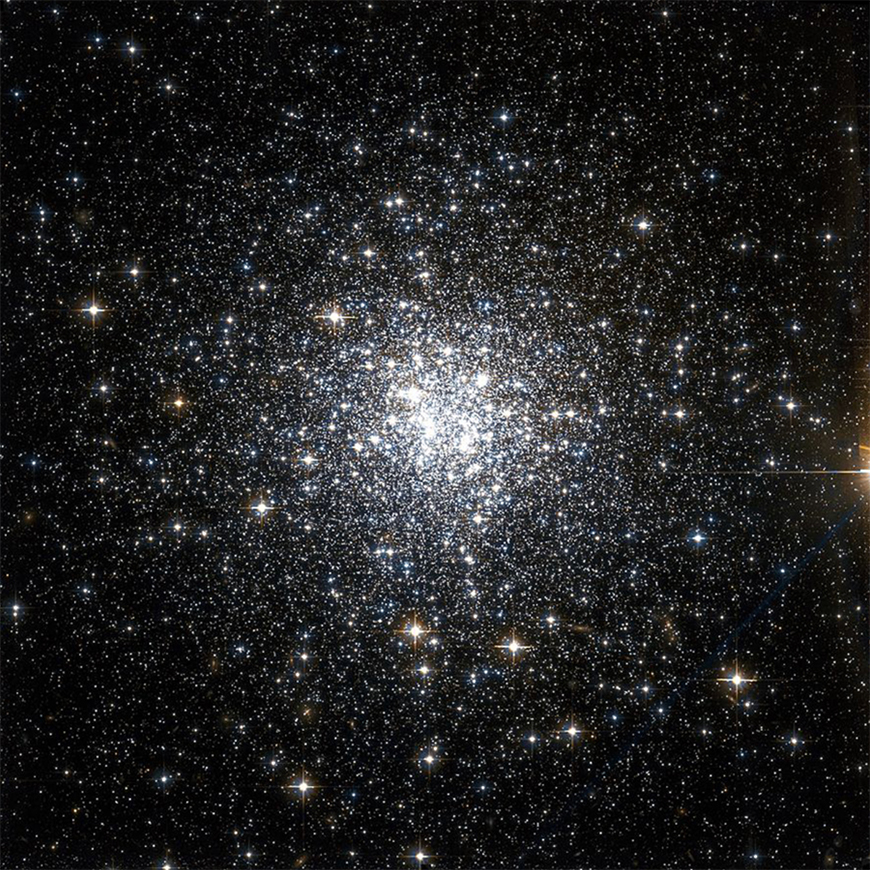
NGC 6934. Image Credit: Hubble Image NASA/ESA, Public Domain.
Herschel also Discovered NGC 7006 which is located some 11 degrees to the NE of NGC 6934. At +10.56, it is one of the fainter of our galaxy's globular clusters. This faintness is understandable when one considers NGC 7006's distance - an amazing 135,000 light years hence. This cluster is described by various observers as quite comet like in appearance - a condensed central region and a halo of stars are not as distinct as they are in its neighbour. A very large telescope of 16+ inches aperture will be needed to resolve individual stars in this challenging target.
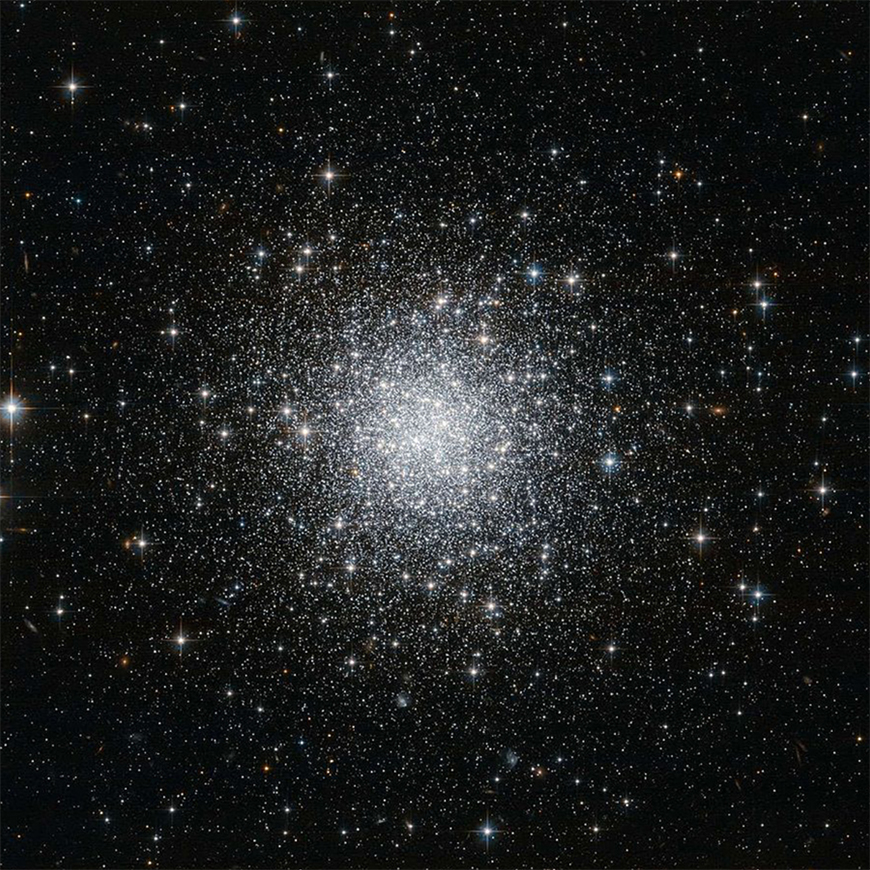
NGC 7006. Image Credit: Hubble Image NASA/ESA, Public Domain.
Delphinus also contains a good planetary nebula: the Blue Flash, or NGC 6905. This is more easily seen in small telescopes than either of the globular clusters previously mentioned. Indeed, it is often overlooked, due to its proximity to the nearby M27 (more of which later), but the Blue Flash deserves more observation. A blue-white ball of light, with extending lobes either side, NGC 6905 is +10.89 mag and 0.8 x 0.6 arcminutes in dimension and lies 2200 light years away. Larger telescopes will start to pick up more of the object's uneven shape and central star. It seems decidedly egg-shaped to some.
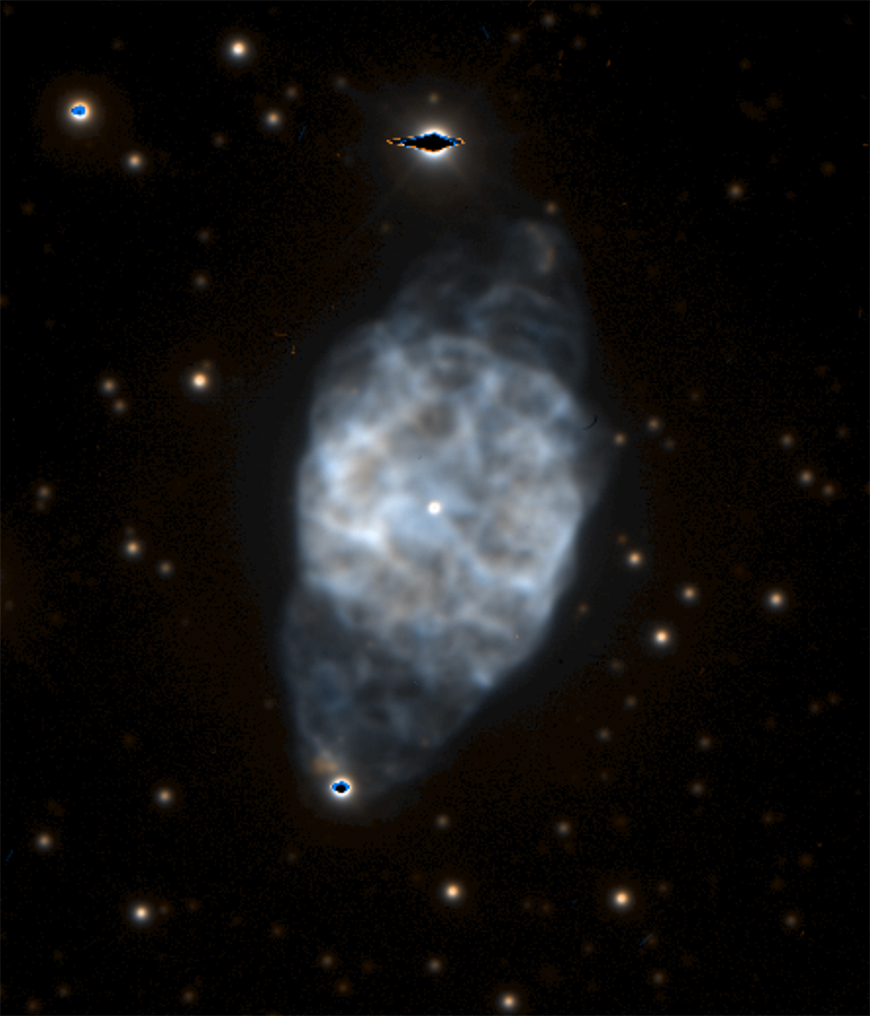
NGC 6905, The Blue Flash Nebula. Image Credit - European Southern Observatory - Creative Commons
Just under 7 degrees to the west of The Blue Flash, over the border into Sagitta, The Arrow, sits another globular cluster - M71.
Discovered in 1746 by Philippe Loys de Cheseaux, M71 is a very loose globular, which was perhaps understandably classed as an open cluster for a considerable amount of time. Binoculars show it well, but smaller telescopes will start to resolve it into stars. At 3.3 arcminutes diameter and +8.18 mag, M71 is a curious beast: its spectral makeup and spread of differing star types is much more suggestive of an open cluster, though observations of the radial velocities of its constituent stars have pointed to its globular nature. It is thought to be particularly young for a globular cluster, being "only" 9 billion years of age.
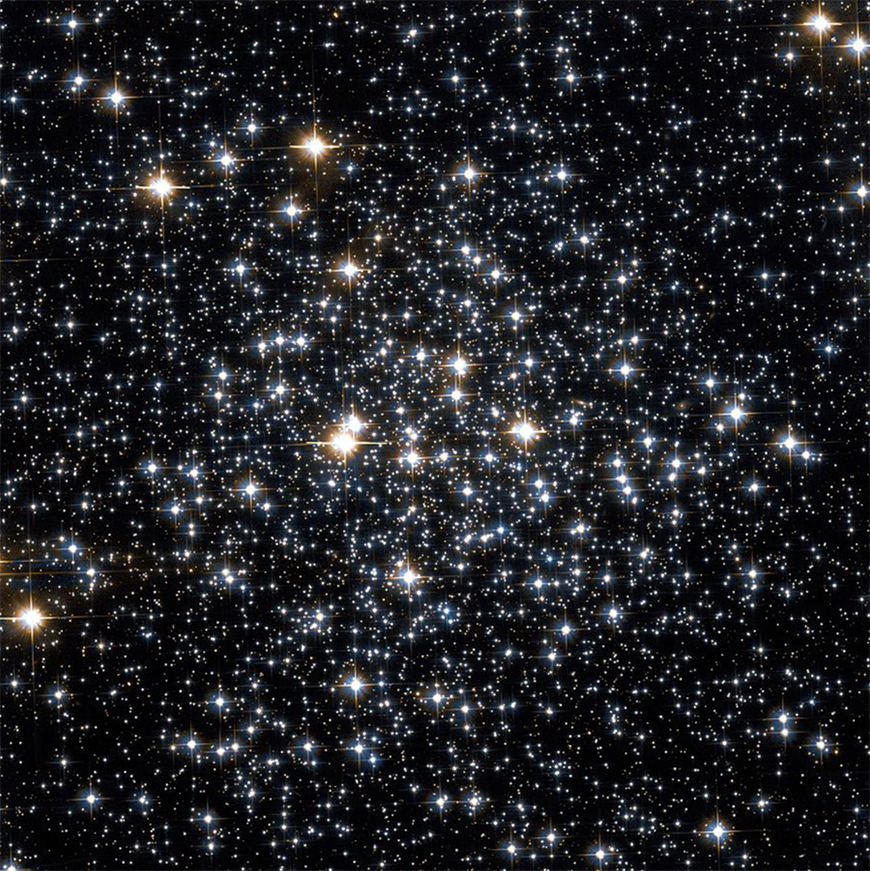
M71. Image Credit: Hubble Image NASA/ESA, Public Domain.
Moving further Westward, over the border into Vulpecula, The Fox, we come to one of the most celebrated clusters in the whole sky - Collinder 399, otherwise known as The Coathanger, for obvious reasons! The asterism of The Coathanger contains ten bright stars, one of which is an orange-yellow colour, which contrasts nicely with the blue-white of the other nine. A perennial binocular favourite, The Coathanger is a large object at 89 arc minutes diameter is best seen in widefield instruments at low powers. Its unlikely appearance always raises a wry smile, as it is one of the sky's greatest practical jokes.
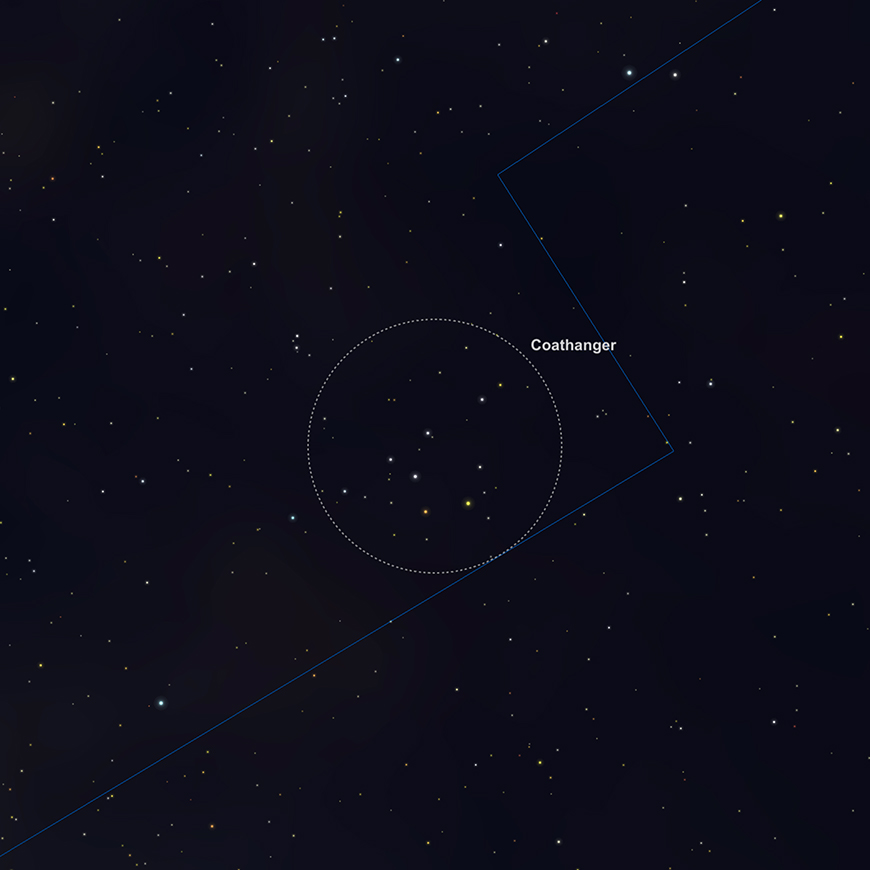
Chart showing the location of The Coathanger Asterism. Image created with SkySafari for Mac OS X, ©2010-2012 by Southern Stars, www.southernstars.com.
From the ridiculous to the sublime, the next object is one of the best examples of its type in the entire firmament - M27, The Dumbell Nebula. This planetary nebula is to be found 8 1/3 degrees to the east of The Coathanger and is a richly rewarding object to observe in any telescope. Small telescopes show it as an elongated glowing box. Larger apertures show more and more of the distinctive "apple core" shape. Long duration exposure images show the whole object, including its ghostly outer layers, beautiful colours and complex internal structure. The Dumbell is a true Messier object, as it was discovered by Charles Messier in 1764 and at about half the diameter of the Moon and +7.09 is easily one of the most prominent examples of its kind in the sky.
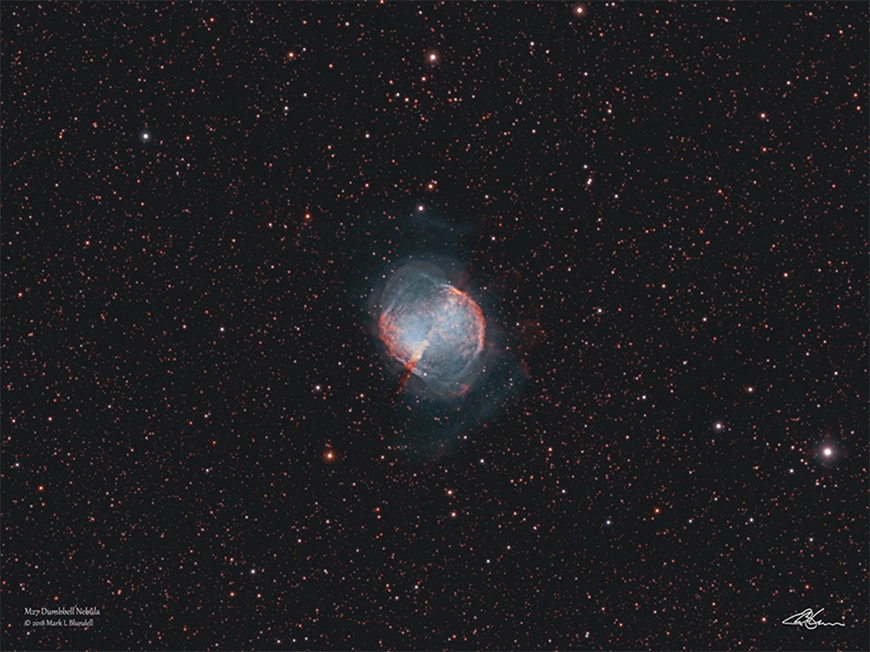
M27, The Dumbell Nubula. Image Credit - Mark Blundell
We see M27 from the side on - hence its less-than-planetary shape. Were we observing it from a polar viewpoint, it would appear ring-like. But we are fortunate that the inner structure of the nebula is so well-defined from our perspective. M27's distance is heavily debated, but now appears to be around 1200-1700 light years away. Its age is thought to be relatively young - 3-4000 years-or-so. It is an easy object to locate and should not be missed by any observer.
NGC 6885 is another inhabitant of Vulpecula and lies 4 2/3 degrees NE of the Dumbell. It is a +8.10 open cluster, around 20 arc minutes in size. Although not exceptionally bright, NGC 6885 is easily located in binoculars and is probably best-seen in a large pair. This cluster contains over fifty member stars and has distance of around 1900 light years.
Eight and a half degrees NE of NGC 6885, across the border into Cygnus is the enchanting target of the Veil Nebula. The Veil Complex – NGCs 6960, 6974, 6979, 6992 and 6995 in Cygnus is a famous Supernova remnant, spread out over six times the diameter of the Full Moon. At combined brightness of +5 mag, The Veil can supposedly be glimpsed with the naked eye under truly exceptional conditions, but is much more likely to be seen (and better observed) in large binoculars and telescopes. The veil lies underneath the wing of Cygnus, close to Gienah (Epsilon Cygni). The brightest section this nebula is NGC6960, otherwise known as The Witches’ Broom, due to its obvious broom-like shape, which reveals itself best in long duration exposures. NGC6960 has the star 52 Cygni apparently buried within it (it is in fact at least 10 times nearer to us), making this part of the nebula an easier target to find with non-Goto scopes. The Veil responds terrifically well to the OIII filter – indeed, it is almost the best-responding nebula to this particular narrowband wavelength. This beautiful structure can be seen in all manner of telescopes, but large instruments with low power, widefield eyepieces present it spectacularly well.
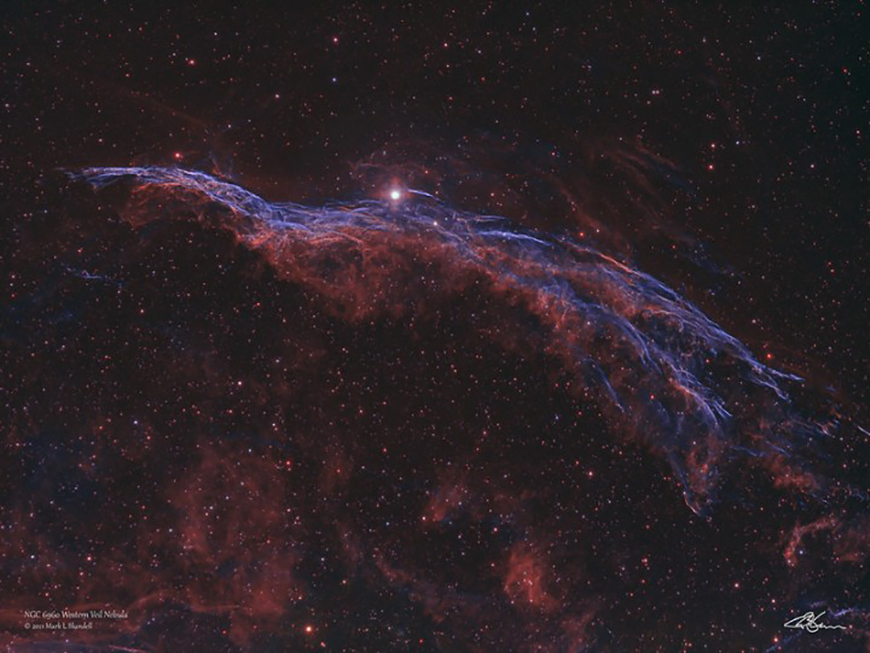
NGC 6960 - Western Veil Nebula, or Witches Broom. Image Credit - Mark Blundell.
Drifting Westwards, past one of the finest double stars in the entire sky, the Creamy Yellow and Electric Blue of Albireo (Beta Cygnii), just across the border into Lyra, The Lyre, sit two notable objects, the first of whichis M56, which lies roughly equidistant between Albireo and Sulafat (Gamma Lyrae). At +8.27, it is of similar brightness to the aforementioned M71, though at 2.2 Arcminutes diameter – when compared to the larger M71 at 3.3 Arcminutes in size – is slightly more condensed and appears brighter. Indeed, both objects would possibly appear more prominent were they not lying so close to the axis of our Galaxy and therefore obscured by parts of the Milky Way.
Roughly halfway between Sulafat and the neighbouring naked eye variable star, Sheliak (Beta Lyrae) sits one of the showpieces of the sky, the wonderful M57, the Ring Nebula. M57's enduring popularity as a Deep Sky target may be partially down to the ease with which its location is to be found. Looking like an elongated smoke ring drifting through space, the Ring Nebula is perhaps the archetype of all planetary nebulae. Discovered in 1779 by the astronomer Antoine Darquier de Pellepoix, Messier was hot on his heels and independently discovered it a matter of days afterwards. Rather disappointing in binoculars, yet easily spotted in most telescopes due to its comparatively high surface brightness, M57 takes magnification and filtration (especially the OIII filter) extremely well. Naturally, the larger the telescope you point at it, the more the keen observer is likely to see, but those with smaller telescopes will not be disappointed as long as you keep magnification up.
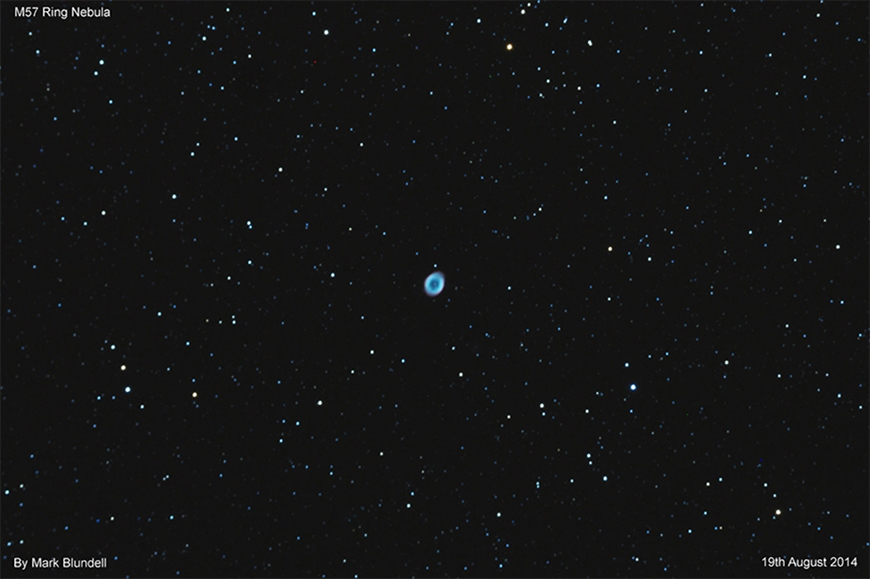
M57, The Ring Nebula, in detail. Image Credit: Hubble Image NASA/ESA, Public Domain.
The Ring Nebula in an amateur telescope. Image Credit, Mark Blundell.
M57's distance is still up for debate, modern estimates of the central star put it at about 1400-4000+ light years away - quite a variation! It is thought is the former figure is the more correct, M57 is about a light year across from widest point to widest point and is a cylinder shape which we see from the end - quite the opposite, in fact, to M27's aspect. It is thought that The Ring Nebula is around 5-8000 years old.
Back into Cygnus, climbing higher North up the spine of the Milky Way, we come to a reasonably diminutive, but nonetheless fascinating object: NGC 6888, The Crescent Nebula. a bright, compact nebula, which is the expanding shell of a Wolf-Rayet Star (HD 192163), which is steadily shedding its outer layers. The nebula glows due to the fact that it is gas is superheated by the collision of the boundary layer of a faster-moving inner solar wind, meeting a less energetic layer of solar wind formed when the gaseous layer of HD192163’s former outer atmosphere was ejected in its previous red giant phase. This bow shock is about 25 light years across and appears to us as a crescent shape, glowing at +7.40 mag. The "surface" of this crescent is incredibly detailed and its complicated texture can be noted in larger telescopes using OIII and UHC filtration. Much beloved of Astrophotographers, the Crescent Nebula is a rewarding target for imagers.
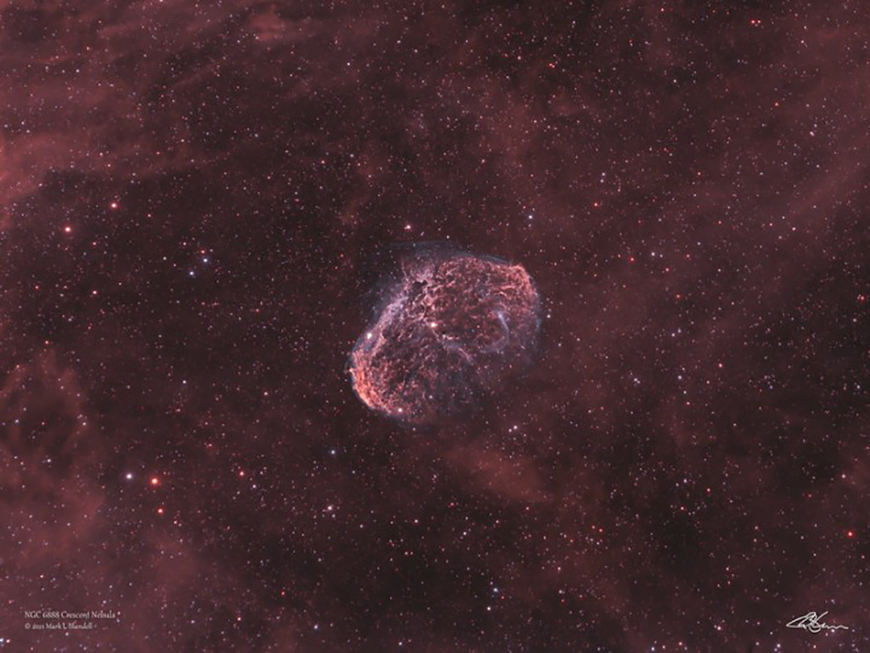
NGC 6888, The Crescent Nebula. Image Credit - Mark Blundell.
Right next door to the Crescent, clustered around the star Sadr (Gamma Cygni) is the vast expanse of the Gamma Cygni Nebula. Glimpsed in large binoculars and telescopes from an appropriately dark locale, IC 1318, or the Butterfly Nebula, as it is otherwise known, is a huge patch of red nebulosity, slightly larger in dimensions than the Veil. However, this nebula is very spread out, so its surface brightness is inherently low. It is best visually isolated with H-Alpha Filters, but is more easily captured in long duration astrophotography. The Gamma Cygni Nebula reaches out behind the Crescent and the star that is takes its name from. Sadr is around 750 light years away, whereas estimates for the distance of the nebula vary wildly from 2000-5000 light years distance.
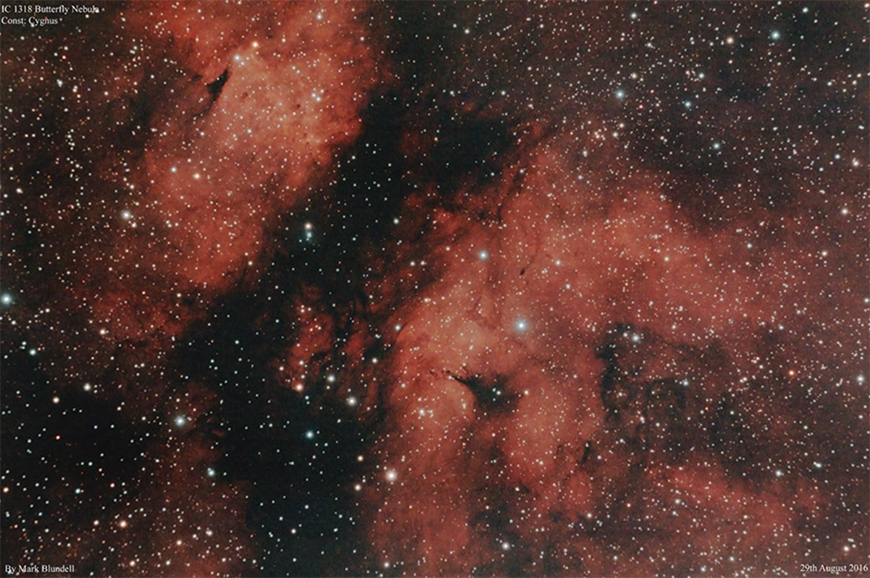
The Butterfly or Sadr Nebula in detail. Image Credit: Mark Blundell.
Further up the spine of Cygnus, just beyond its principal star, Deneb, is another vast nebula system: the North America Nebula (NGC7000) and tucked underneath it, the Pelican Nebula (IC5070). Of the two, the North America is undoubtedly brighter (at +4 mag, compared to the Pelican’s +8 mag) and can be seen very well in large binoculars from a dark site. An OIII or H-Beta filter can be used successfully to enhance NGC7000 in widefield telescopes, but the complex does not respond well to magnification. Both nebulae are part of the same gas cloud, which may be ionised by emissions from nearby Deneb. If this is the case, their distance would be in the region of 1800+ light years away from our Solar System.
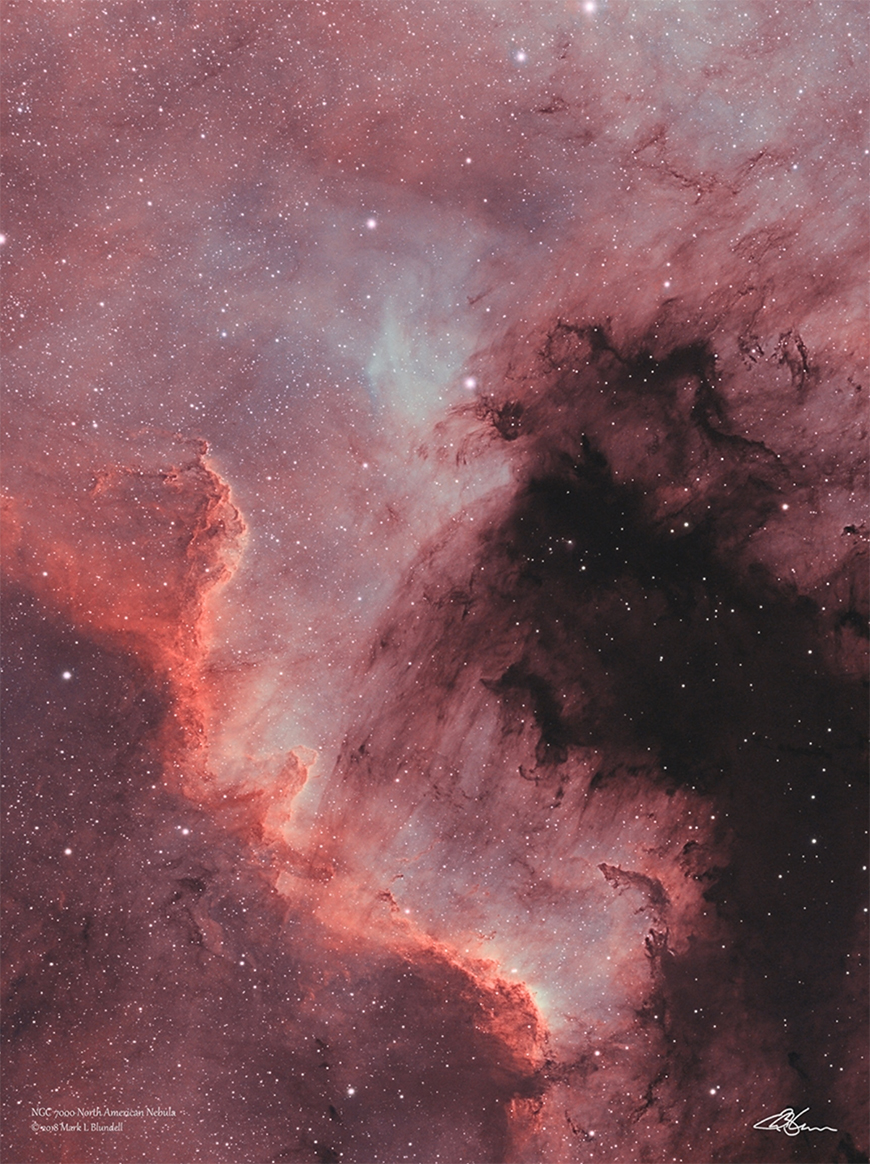
NGC 7000, The North America Nebula. Image Credit - Mark Blundell.
Last, but not least, is a much smaller object, the Blinking Planetary or NGC 6826. This nebula is 2.1 arc minutes in diameter and located towards Iota Cygni. Dimensionally, NGC6826 is fractionally larger than the Ring Nebula and about the same brightness. The "blinking" nature of this planetary is caused when an observer stares at the nebula’s central star, at medium to high power, this overwhelms the eye and the nebula fades from view. When you look away to the nearby +8.5 magnitude star in the same field, the nebula reappears. This is not a unique phenomenon and is noted in other compact planetary nebulae with prominent central stars, but is best seen in the Blinking Planetary. Visually, the NGC6826 present two brighter regions on either side of its disc. These regions are Fast Low-Ionization Emission Regions or FLIERs for short. These FLIERs are parts of the planetary formation which are expanding at extreme speeds in comparison to the surrounding nebula. It is postulated that these areas are so dense that the ionising effect of the ultraviolet radiation emitted from the parent star cannot penetrate them. The Blinking Planetary and the Saturn Nebula are two of the best known examples of planetaries that exhibit these FLIERs.
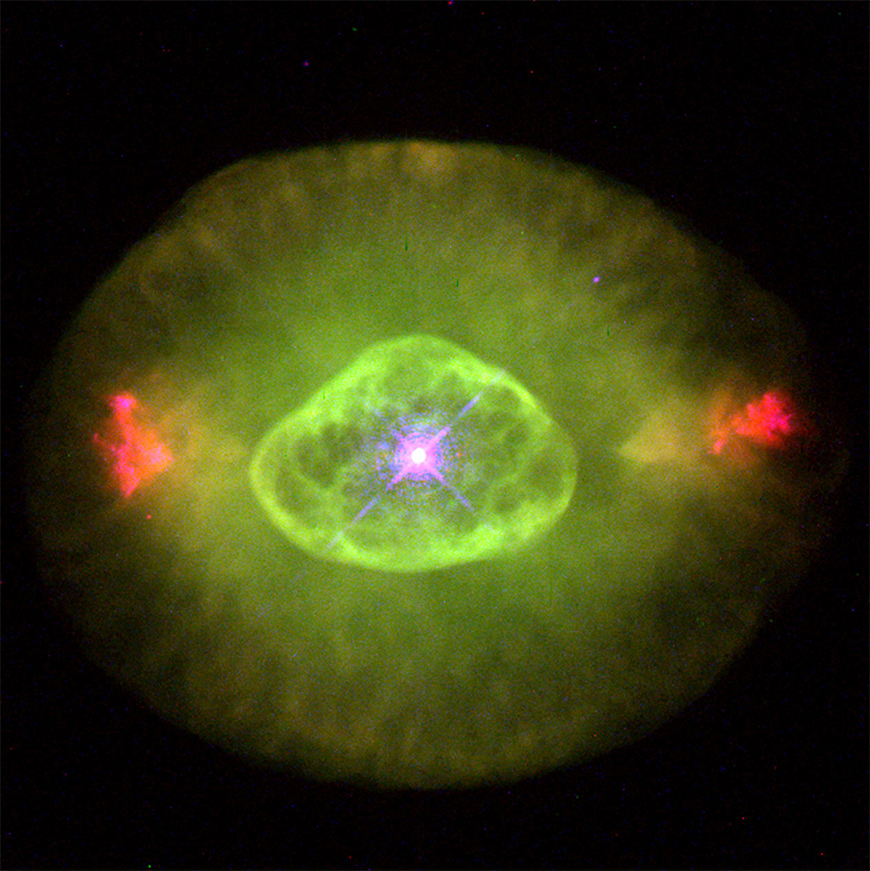
NGC 6826, The Blinking Planetary. Image Credit: Hubble Image NASA/ESA, Public Domain.
Text - Kerin Smith

 English
English